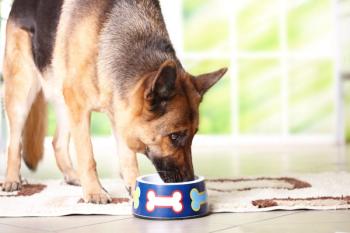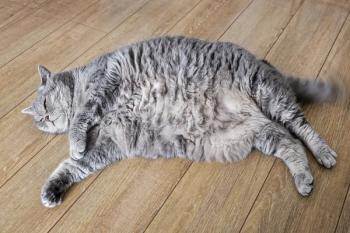
Case study: Stimulating the appetite of a geriatric dog with chronic comorbidities
In this case, the owners knew their longtime companion was frail, and they were addressing his multiple health concerns. But when the dog quit eating, they knew something more needed to be done to bring him comfort.
Presenting complaint and history
To download a 6-page PDF of this case study,
The owners wanted Nikki to be as comfortable as possible, and his hyporexia/anorexia was a substantial concern to them. They reported that Nikki was still drinking water, and that he was routinely fed a low-fat diet because of a history of pancreatitis. Nikki was also receiving pimobendan because of an undefined heart murmur.
Referral evaluation
On presentation, Nikki was lethargic. Physical examination revealed Nikki weighed 6 kg, had a body condition score of 5 (on a scale of 1 to 9) with moderate muscle loss and exhibited mild dehydration (5%). His temperature was 99.1 F, his pulse was 160 beats/min., and his respiratory rate was 20 breaths/min. He had moderate dental disease and a grade V/VI left-sided apical systolic murmur.
Initial diagnostic testing revealed azotemia with poorly concentrated urine. Further evaluation established concurrent severe chronic kidney disease and stage B2 chronic valvular heart disease (see Table 1 for diagnostic findings).
Treatment
Day 1
Nikki was admitted to the hospital and received intravenous fluids to replace the fluid deficit (300 ml) over 12 hours with careful monitoring. Warmed oats were used to address hypothermia. A proton-pump inhibitor (pantoprazole) and an antiemetic (maropitant) were administered parenterally, along with ampicillin-sulbactam for possible pyelonephritis or leptospirosis.
Day 2
On the second day, Nikki was transferred to the Internal Medicine Service. The intravenous fluids and other medications were continued, and because Nikki was still refusing food, capromorelin oral solution (ENTYCE®) was administered at 3 mg/kg to stimulate his appetite.
A few hours after receiving capromorelin, Nikki began eating a low-fat, canned food, despite persistent severe azotemia (creatinine concentration of 6.4 mg/dl). Because Nikki's hydration status was normal, and he was alert, responsive and drinking water, the intravenous fluids were tapered and discontinued during the next 24 hours.
Nikki, 14-year-old patient and beloved petDay 3
Nikki continued to eat well. Since the urine culture and leptospirosis titers were negative, the antibiotic was discontinued. Sevelamer was prescribed to mitigate hyperphosphatemia, and the proton pump inhibitor was switched to an oral product (omeprazole).
Nikki was discharged from the hospital on Day 3, with instructions to continue capromorelin long-term at home. Oral maropitant (3 days' worth) was dispensed, and the owner was instructed to restart the pimobendanand continue with a low-fat diet. The owners were advised to schedule a follow-up appointment with Nikki's primary care veterinarian in a few days, so that his body weight, overall condition, azotemia and hyperphosphatemia could be reassessed.
Because of chronic kidney disease and heart disease, Nikki's long-term prognosis was guarded, but getting him home, eating and comfortable was a positive outcome for the owners.
The consequences of dysrexia
Patients develop anorexia or dysrexia for a number of reasons, and it typically reflects a primary disease. For example, if a dog has ascites due to cancer or heart failure, the fluid can make eating uncomfortable. Patients that develop encephalopathy with liver failure do not eat well. Pain from pancreatitis, a fracture, kidney failure/uremia, ketosis, acute infection-all can inhibit appetite. Diseases that result in inflammation or other changes in the gastrointestinal tract can delay emptying and cause anorexia.
Extensive research exists in human medicine about the impact of dysrexia on patient outcomes, but little research is available in the veterinary literature. Veterinarians know from experience, however, that veterinary patients do not do well when they do not eat. Dysrexia may result in delayed wound healing, decreased immune responses and decreased musculoskeletal strength. Weight loss also occurs, but it may take several days to become apparent. The health problems listed above may be well-established before weight loss is observed, thus we shouldn't wait for it to occur in patients with dysrexia.
A dog's inappetence may also adversely affect the owners. If a dog doesn't eat, owners perceive it to be suffering, raising questions about quality of life. When I call owners to give them an update on a hospitalized patient, the first question they ask is, “Did he eat today?” The same thing is true when a patient is at home. I use food intake as a measure of comfort and well-being when I discuss how the patient is doing with the owners.
Good evidence exists that nutrition has a marked impact on gastrointestinal tract health. A lack of nutrients in the intestinal lumen compromises mucosal function. Enterocyte turnover slows, the intestinal villi become blunted, and permeability increases. Metabolic derangements can occur, such as hepatic lipidosis (although the effects are less dramatic in dogs than in cats). Anorexia also impacts the gastrointestinal microbiome. The predominant bacterial species may shift to less-friendly bacterial species. All of these processes combine to impact patient survival. In short, patients need adequate nutrition if they are to survive.
Stimulating the appetite
Veterinarians should consider every reason an animal may not be eating enough-pain, psychological stressors or physiologic issues (including gastric stasis, ulceration or esophageal reflux). Dysrexia is often a problem with several contributing factors, and it is likely that multimodal management will be necessary. Addressing as many of the factors as you can is the best way forward.
In a given case, if you determine that part of the problem is inadequate food intake, then you will want to stimulate the dog's appetite. Several drugs have traditionally been used as appetite stimulants, though they are not designed for this purpose. These include mirtazapine, cyproheptadine, diazepam, tetrahydrocannabinol and glucocorticoids. These drugs have different mechanisms of action, but none of them are FDA-approved as an appetite stimulant for dogs, and their efficacy and safety profiles are uncertain.
Ghrelin's role
In 1999, the “hunger hormone” known as ghrelin was discovered. It is made primarily in the stomach, with levels rising during the interprandial interval. Ghrelin's function in the body is complex. It is integral to not only the regulation of appetite but also to the maintenance of homeostasis and energy metabolism. Besides stimulating food intake, ghrelin stimulates growth hormone secretion, decreases energy expenditure, reduces gastric acid stimulation, accelerates gastric emptying, impacts glucose homeostasis and modulates cardiovascular function, inflammation, reproductive function and bone formation.*
Ghrelin achieves its ability to stimulate appetite through activation of the orexigenic neurons and suppression of the anorexigenic neurons in the hypothalamus. (Orexigenic means driving food intake, and anorexigenic means inhibiting food intake.) Ghrelin also affects dopamine levels in the hippocampus. Ghrelin has a very short half-life and very poor oral bioavailability, so it is not possible to simply administer it to anorexic patients.
Capromorelin (ENTYCE) is one of the agents that act like ghrelin, and extensive studies have evaluated the efficacy and safety of capromorelin in dogs. Capromorelin is a ghrelin receptor agonist that binds to receptors in the hypothalamic hunger center, thereby increasing food intake. It also binds to the growth hormone secretagogue receptor and somatotrophs in the pituitary, triggering growth hormone release. These processes combine to prompt the patient to eat and to use those calories to help with weight gain (Figure 1).
When to use appetite stimulation
At the Texas A&M College of Veterinary Medicine & Biomedical Sciences Veterinary Teaching Hospital, we use capromorelin in dogs recovering from an acute illness, those with chronic illness, those recovering from surgery or trauma and those transitioning to a therapeutic diet that may be less palatable.
Acute conditions
In acute illness such as acute hemorrhagic diarrhea or nonspecific acute gastritis, we provide supportive care for the dog as the disease takes its natural course. We prefer not to discharge these patients until they are eating, as they may otherwise be quickly readmitted by an anxious owner. Capromorelin can stimulate these patients to begin eating and allow us to administer oral medications as needed. We usually recommend that the owner finish giving the bottle of capromorelin at home, particularly if the dog is being fed a bland food for a few days.
Chronic illnesses
We also prescribe capromorelin for dogs with chronic conditions, such as chronic kidney disease. My colleagues in oncology and cardiology use it in many of their long-term cases, too. Keeping these dogs eating makes it easier for owners to administer oral medications. In addition, the quality of life is much better for both the dog and the owner if the dog is eating well.
Postoperative recovery or healing after trauma
We also use capromorelin in postoperative or trauma patients. These dogs may be receiving multiple medications, such as analgesics and antibiotics, and may be subject to repeated sedation for bandage changes or wound management. All of these factors can markedly impact appetite, just when the dog needs more calories for healing. Capromorelin can be a valuable tool in these cases, as it increases food intake which supports healing and the preservation of muscle mass.
Diet transitions
We also use capromorelin to help patients with pancreatitis or gastrointestinal diseases, such as inflammatory bowel disease or lymphangiectasia, transition to a therapeutic diet. I use capromorelin as soon as possible in these cases, before food aversion arises or the owner gives in to the dog when it begs for its old food.
Clinical considerations in this case and others
Dogs, like Nikki, with chronic kidney disease may present with an acute episode of illness. In the absence of vomiting, an antiemetic is unlikely to improve the patient's food intake as it has no effect on the hunger center. Simply administering antiemetics and acid inhibitors is not expected to address the owners' concerns about the dog's hyporexia/anorexia.
Dietary recommendations should balance the coexisting medical conditions (pancreatitis versus chronic kidney disease). An appetite stimulant should be added to the treatment protocol for any animal with a history of inadequate intake, as in Nikki's case, and many others. (See sidebar When to use appetite stimulation.)
*Rhodes L, Zollers B, Wofford JA, Heinen E. Capromorelin: a ghrelin receptor agonist and novel therapy for stimulation of appetite in dogs. Veterinary Medicine and Science, Nov. 6, 2017. https://doi.org/10.1002/vms3.83
Actual patient case study provided by Audrey K. Cook, BVM&S, Msc Vet Ed, DACVIM, DECVIM, DABVP (Feline Practice); Associate Professor, Texas A&M University.
Newsletter
From exam room tips to practice management insights, get trusted veterinary news delivered straight to your inbox—subscribe to dvm360.




